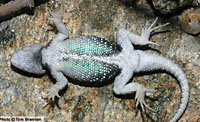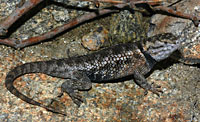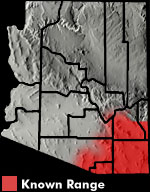Online Field Guide to The Reptiles and Amphibians of Arizona



Cochise County, AZ
 Venter. Cochise Co., AZ |
| TWIN-SPOTTED SPINY LIZARD Sceloporus bimaculosus | |
|
DESCRIPTION: A large (up to about 142 mm or 5.6″ from snout to vent), stocky lizard with large, pointed, keeled, overlapping scales. Base coloration is gray, tan, or brown. Males have two longitudinal rows of dark blotches on the back. Yellow or orange scales are sporadically scattered on the sides of the body. A black wedge shape marks each shoulder. Males have two large, bright, blue-green patches on the belly and a blue-green patch on the throat. Belly and throat patches are faint or absent in females. Its large, black, wedge-shaped shoulder markings distinguish this lizard from many of Arizona’s other Sceloporus. Its rows of dark blotches on the back (in adult males) distinguish this lizard from the Desert Spiny Lizard. Its lack of bars on the forelimbs distinguish it from Clark’s Spiny Lizard. The similar Yarrow’s Spiny Lizard has a complete collar. DISTRIBUTION: The Twin-spotted Spiny Lizard ranges across southeastern Arizona at elevations ranging from about 750 m (2,500′) to about 1,500 m (5,000′). HABITAT: The Twin-spotted Spiny Lizard is found primarily in Chihuahuan Desertscrub and Semidesert Grassland communities. It is usually encountered on lower slopes, bajadas, plains, and low valleys, often in the branches of trees or in the vicinity of ground cover such as wood piles, rock piles, and packrat nests. BEHAVIOR: This diurnal lizard basks on the branches of trees, on rocks, or on other sunlit perches. When encountered it is often heard before it is seen as it scratches and claws the bark en route to the opposite side of the trunk or branch. It flees down into the inner tangles of pack rat nests, rock crevices, or burrows when threatened. It has a strong jaw and often bites when captured. It hibernates during the cold months of winter and late fall. DIET: The Twin-spotted Spiny Lizard feeds on a variety of insects including ants, beetles, and caterpillars. It also feeds on spiders, centipedes, small lizards, and some plant material. Before seizing prey it rapidly vibrates the tip of its tail. REPRODUCTION: It is often encountered in male-female pairs. Mating takes place in spring and summer and one or two clutches of eggs are laid in spring and summer. Clutch size ranges from 2 to 12 eggs. Hatchlings may appear as early as late May but usually begin to emerge in July. By Thomas C. Brennan Brennan, T. C., and A. T. Holycross. 2006. A Field Guide to Amphibians and Reptiles in Arizona. Arizona Game and Fish Department. Phoenix, AZ Brennan, T. C., & A. T. Holycross. 2005. A Field Guide to Amphibians and Reptiles of Maricopa County. Arizona Game and Fish Department. Phoenix, AZ Phelan, R.L., and B.H. Brattstrom. 1955. Geographic Variation in Sceloporus magister. Herpetologica. 11 Schulte, J.A., J.R. Macey, and T.J. Papenfuss. 2006,A genetic perspective on the geographic association of taxa among arid North American lizards of the Sceloporus magister complex (Squamata: Iguanidae: Phrynosomatinae) Molecular Phylogenetics and Evolution 39: 873–880 Stebbins, R.C. 2003. A Field Guide to Western Reptiles and Amphibians, Third Edition. Houghton Mifflin Company, Boston, MA. |
|
Visit Partners in Amphibian and Reptile Conservation:


HOME
Copyright © 2023, Arizona Game and Fish Department. All rights reserved.
If you make use of the textual contents of this site in reports, publications, etc. please cite and credit the author(s) and photographer(s). All photos on this website are copyrighted. However, those found in the species account section may be used for any noncommercial scientific, educational, or conservation purposes provided that photographs are not altered and continue to bear the copyright symbol and name of the photographer. Please contact the photographer regarding commercial use of copyrighted photographs.











